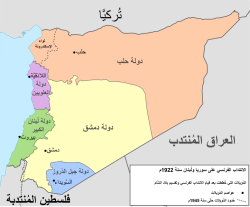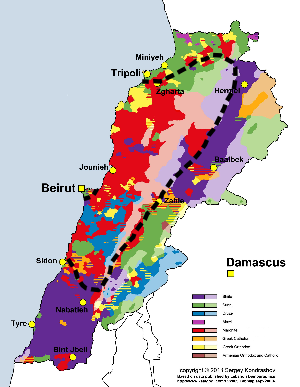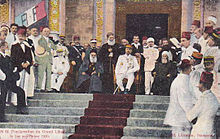大黎巴嫩国
外观
此条目目前正依照英语和法语版本上的内容进行翻译。 (2024年12月27日) |
| 1920年—1943年 | |||||||||
 叙利亚及黎巴嫩托管地,绿色为大黎巴嫩 | |||||||||
| 地位 | 法国保护国下的自治国家 | ||||||||
| 首都 | 贝鲁特 | ||||||||
| 常用语言 | 阿拉伯语、法语、英语、亚美尼亚语 | ||||||||
| 宗教 | 伊斯兰教、基督教 | ||||||||
| 政府 | 联邦下的半独立共和国 | ||||||||
| 历史时期 | 战间期与第二次世界大战 | ||||||||
• 建立 | 1920年 | ||||||||
• 终结 | 1943年 | ||||||||
| 货币 | 黎巴嫩-叙利亚镑 | ||||||||
| |||||||||
大黎巴嫩国(法语:État du Grand Liban)又译大黎巴嫩州或大黎巴嫩邦(英语:State of Greater Lebanon)通称大黎巴嫩(阿拉伯语:دولة لبنان الكبير),是于1920年至1926年间,属于法属叙利亚及黎巴嫩托管地下的一个自治国家,1926年脱离叙利亚联邦改隶为黎巴嫩共和国(阿拉伯语:الجمهورية اللبنانية)。
背景
[编辑]起源
[编辑]
在1861年,欧洲国家与奥斯曼帝国谈判通过自然规管协议[暂译],同意在帝国的地方成立黎巴嫩山穆塔萨勒夫领,来保护当地的基督徒人口。到一次大战过后,该穆塔萨勒夫领与其他周边分区合并,成为大黎巴嫩国,面积多了大概一倍。
词源
[编辑]“大黎巴嫩”(法语:Le Grand Liban)首先由黎巴嫩学者 Bulus Nujaym 和 Albert Naccache 在1919年巴黎和会期间提出[1]。
Nujaym 曾经在1908年出版了很受欢迎的书本《La question du Liban》(黎巴嫩问题),该书的550页中提出了成立大黎巴嫩国的理由,认为扩大版图是对黎巴嫩的经济稳定有必要[2]。
巴黎和会
[编辑]
在巴黎和会期间,黎巴嫩由马龙尼的牧首 Elias Peter Hoayek 代表,他在1919年10月27日和会里提出了建议,希望扩大黎巴嫩山穆塔萨勒夫领的范围。虽然这些地区并非主要由基督徒聚居,但他仍认为这些地方是黎巴嫩的自然一部分[3]。该提议有部分是基于穆塔萨勒夫领有一半人口因黎巴嫩山大饥荒而丧失,而当地教会希望扩大的版图能够更有效地为居民提供食粮[4]。扩大的地区包含了的黎波里、贝鲁特、赛达、和推罗这几个大城市,和他们的周边地区[3]。
参见
[编辑]参考文献
[编辑]- ^ Marwan R. Buheiry. Bulus Nujaym and the Grand Liban Ideal, 1908–1919. Intellectual Life in the Arab East, 1890 to 1930. Syracuse University Press. 1 June 1981: 63. ISBN 978-0-8156-6086-6.
This article, bearing the dateline of Jounieh, July 10, 1919, constitutes, together with Albert Naccache’s "Notre avenir économique published also in La Revue Phénicienne (July 1919), perhaps some of the earliest written and public references to a Grand Liban. For instance, the term does not appear to have been used seven months earlier by the first Lebanese delegation to Paris - at least not in its official releases. Or to cite a later example, the term was not used in the important correspondence from Clemenceau to Maronite Patriarch Huwayik dated 10 November 1919
- ^ Meir Zamir. The formation of modern Lebanon
 . Cornell University Press. 1988: 15–16. ISBN 978-0-8014-9523-6.
. Cornell University Press. 1988: 15–16. ISBN 978-0-8014-9523-6. Nujaym’s formulation was to become the basis for Lebanese Christian arguments in favor of a Greater Lebanon. It stressed the national rather than economic aspects of that goal. Only extended boundaries would enable Lebanon to exist as an independent state. Nujaym told the European public that the Lebanese question required a definite solution: the establishment of an independent Christian state.
- ^ 3.0 3.1 Salibi 1990,第26页: "Since the turn of the century, however, the Maronites had pressed for the extension of this small Lebanese territory to what they argued were its natural and historical boundaries: it would then include the coastal towns of Tripoli, Beirut, Sidon and Tyre and their respective hinterlands, which belonged to the Vilayet of Beirut; and the fertile valley of the Bekaa (the four Kazas, or administrtative districts, of Baalbek, the Bekaa, Rashayya and Hasbayya), which belonged to the Vilayet of Damascus. According to the Maronite argument, this 'Greater Lebanon' had always had a special social and historical character, different from that of its surroundings, which made it necessary and indeed imperative for France to help establish it as an independent state. While France had strong sympathies for the Maronites, the French government did not support their demands without reserve. In Mount Lebanon, the Maronites had formed a clear majority of the population. In a 'Greater Lebanon', they were bound to be outnumbered by the Muslims of the coastal towns and their hinterlands, and by those of the Bekaa valley; and all the Christian communities together, in a 'Greater Lebanon', could at best amount to a bare majority. The Maronites, however, were insistent in their demands. Their secular and clerical leaders had pressed for them during the war years among the Allied powers, not excluding the United States."
- ^ Harris 2012, pp. 173–174


